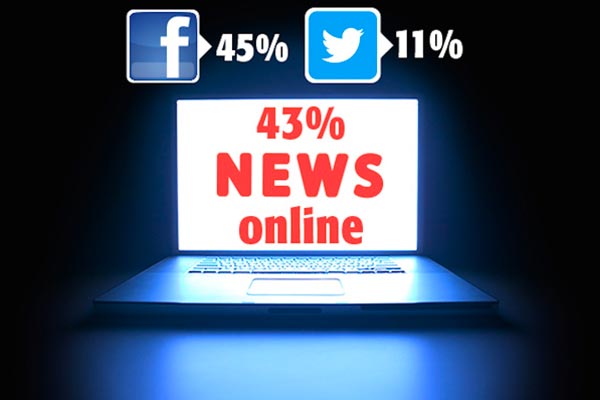
Have you ever tried to stream a news report when there’s something major happening, only to get super slow service, or a failure to connect completely? You’re not alone. These days, when there’s a major news story or natural disaster in the making, data usage goes through the roof.
Consider this: As of August 2017, 43% of Americans report often getting news online. Two-thirds (67%) of Americans report that they get at least some of their news on social media—with two-in-ten people doing so often, according to a survey from Pew Research Center.
Just under half of all Americans (45%) report getting news from FaceBook. Twitter is enormously popular for those seeking quick hits of news, probably due to the U.S. having a president who is quite fond of the platform. A vast majority of Twitter users (74%) say that they’re on the site for news. However, the Twitter audience is far smaller than that of Facebook, so the numbers add up to just 11% of U.S. adults getting their news from Twitter.
Internet usage really spikes when there’s a major breaking news event, such as when a presidential election is being decided.
Facebook saw an increase of almost 30% on the night of the U.S. presidential election in 2016, while Twitter traffic more than doubled. If you wanted to watch Netflix, you were in luck. That site, which is typically the largest source of internet traffic in North America, saw a huge decline. Its traffic levels dropped by 25% from the previous day.
Super Bowls and Super Storms Make for Super Data Days
It’s not just politics that causes data usage to spike—sports and weather events can also break the Internet.
Earlier this year, Super Bowl 51 made digital history, racking up record-breaking data usage stats. NRG Stadium in Houston saw 11.8 terabytes of data traverse its Wi-Fi network during the game. Almost half of the fans in attendance (49% or 35,430 unique users) were on Wi-Fi at some point. Social media accounted for nearly 12% of the data being used by fans.
Superstorms make for super data usage, as well. Back in 2012, when Superstorm Sandy devastated the East Coast, people sent more than 20 million Tweets about the storm during the 5-day period from October 27 to November 1. People were using the search and discover functionality, along with trending topics, to get the most up-to-date information on what was going on, and, of course, sharing their own experiences.
More recently, a series of devastating hurricanes, starting with Harvey and ending with Maria, left people turning to apps and social media.
Data usage during the Sunday coverage just ahead of Hurricane Irma was over 5% higher than the average of the three previous Sundays, OpenVault CEO Mark Trudeau said at a recent Mid-America Cable Show panel.
In Southeast Texas, just after Hurricane Harvey hit, Internet walkie-talkie app Zello became the go-to app for rescuers working to save thousands of people trapped by floodwaters. Downloads of that app spiked so severely as Hurricane Irma approached Florida and the Caribbean that Zello experienced service slowdowns and disruption.
Other apps proved to be just as popular. At a press conference just before Hurricane Irma was scheduled to make landfall, Florida Governor Rick Scott told state residents to turn to apps and other online resources to find fuel, navigate safely, and stay connected.
Social media proved to be the primary way for those caught in the path of Hurricane Irma, followed closely by Hurricane Maria, to share pictures and experiences, as well as to let loved ones know they were safe—or to inquire about the well-being of others. With phone lines and power out on islands like Dominica, residents were communicating with the outside world primarily through WhatsApp.
In this digital age, data, app, and social media usage are inextricably linked with how we consume news and react to what’s happening in the world. When something major happens, data usage climbs dramatically. With infrastructure continuing to improve and using the best internet provider in your area, we can stay connected no matter what major events come our way.